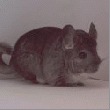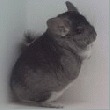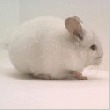
Volume 1, Number 5
Chinchillas.com Newsletter
Auction
Update
Market Prices and Color
Brevicaudata-type chins
Chinchilla Hay
Ear Tags
Auction Update
This week on the auction, we finally have another good show quality ebony female, after many weeks without one. Good quality ebony females have become possibly the most in-demand chinchilla in the market today. We are also increasing our efforts to promote high quality standards by offering them regularly on the auction. High quality standards are the most important asset to a herd with the goal of producing top mutation chinchillas. Behind many great mutation breeders is a successful standard line. We are offering two very good quality standards this week. For the aspiring wrap-around violet producers, we also have a good violet ebony carrier male (homo violet / hetero ebony). Additionally, we are offering for the first time a top show quality ebony/white/beige hybrid female.
The $25 discount offered starting in June to winning bidders who were the first to bid on that auction was very well received. We have decided to continue this offer through the month of September. If you are the only bidder on an auction, you will receive $25 off of the starting bid. Please note that the $25 discount does not apply to auctions listed in the promotions/discounts category.
Several weeks ago, we added the pairs/colonies category to the Auction. Buyers can select a pair knowing that the pair has been professionally selected for color genetic and trait compatibility, giving the new breeder the best chance of acquiring a quality producing pair.
September 1, 2002

Auction Update

1495
Show Quality
Standard Female

1562
Herd Improvement
Standard Male

1582
Light Tan &
White Mosaic Female
Market Prices
and Color
We often hear the question "how much is this color?" Color has less to do with the price overall than the quality does. The chinchillas on the site are all assessed for quality before being priced. Keep in mind that the closer a chinchilla is to 8+ months of age, the more accurate the assessment will be. The younger the chinchilla is, the harder it is to accurately assess what it will develop into, even by its own breeder. Chinchillas are priced according to quality foremost, and then secondly color and market demand are taken into account. A standard can be worth $75 or $500, based on size, fur texture and length, color hue, veiling, conformation, pedigree, etc... The specific mutation color is neither as important nor as hard to achieve by the breeder as quality, but the combination of the two is what makes a specific chinchilla highly valuable. It should be noted that a top show quality standard, mutation or hybrid will often sell for 2 to 4 times as much as its 'not for show' quality counterpart.
Brevicaudata-type chins
There is always a lot of interest in breeding and marketing the brevicaudata-type chinchilla. Though there are no pure brevicaudatas available in the US, breeders often produce a lanigera cross that resembles a brevicaudata chinchilla. Pure brevicaudatas are both endangered and protected in their native habitat, and are no longer available without a special permit. The pure brevi is a somewhat off-color or "yellow" chinchilla, with a docile temperament, blocky body, and short tail and ears. They also tend to have a wavy-type fur.
There are some important things to remember when attempting to breed a 'brevi-type' chinchilla. It is not uncommon for females to have a difficult time giving birth to kits with an extremely brevi-type head, especially if the dam is of small to medium build, not of brevi-type herself, or has a narrow birth canal. The 'beluga headed' kits are difficult for the females to litter. They can become stuck, especially if breech. Breeders need to be careful to select the right females to produce brevi-type offspring. It is probably wise to breed a brevi type female to a costina or lanigera type male, and brevi type males should be bred to extra large females.
Chinchilla Hay
Chinchillas should have an unlimited supply of clean, mold-free grass hay. Chinchillas should not be fed substantial amounts of legume hays. Legume hays include alfalfa, red clover and vetch, which are all are too high in protein for chinchillas. Alfalfa has its place, but it should be fed in limited quantities and for specific reasons. Good chinchilla grass hays are brome, bermuda grass, timothy, orchard grass, oat, etc…. These grass hays supply a better roughage to protein ratio for the chinchilla. Make sure the hay has not been sprayed with herbicides, pesticides, or fungal innoculant. Even "drift" from a neighboring field that is being sprayed can be enough to harm a chinchilla.
Ear Tags
Clients often ask how to read ear tags, and why they
are used. Ear tags are a way of positively identifying a chinchilla,
who bred it, what year it was born, and it’s order in the herd. One
side of the tag is stamped with the breeder brand. The other side is stamped with a year letter and number. Breeders universally use the same year-letter to designate specified years. L, for example, was the letter used universally for 2001. L103 means
that the chinchilla was the 103rd chinchilla tagged in the herd that year.
Chinchilla do not
have to be tagged, but ear tags can help to identify a chinchilla
that has escaped from its cage. Ear tags have the disadvantages of possibly becomming ensnared and tearing the ear, or of becomming infected. They should be monitered and removed when necessary.
Your personal preferences are set to receive newsletters and surveys from chinchillas.com. To modify your personal preferences and unsubscribe, go to http://www.chinchillas.com/personal and log in to your personal account, select View/edit your personal information then change "participate in survey" to no and "on mailing list" to no.
Copyright© 2002 Chinchillas.com All rights reserved. Designated trademarks and brands are the property of their respective owners.